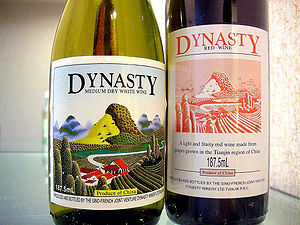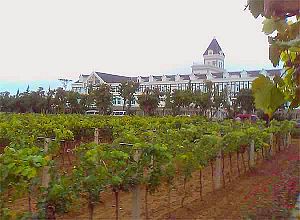- Wine in China
-
This article is about grape wine made in China. For other alcoholic beverages translated as "wine" that originates in China, see Chinese alcoholic beverages.
Wine in China (Chinese: 葡萄酒; pinyin: pútáo jiǔ) refers to grape wines that are produced in China. Grape wine has a long history in China, along with other Chinese alcoholic beverages.
Beginning in 1980, French and other Western wines began to rise in prominence in the Chinese market, both in mainland China and Taiwan. French-taught Chinese winemakers introduced wine to a market dominated mostly by beer, and have quickly expanded in scale such that China, with its immense population, is set to become the largest wine market in the world.[1]
Contents
History
The history of Chinese grape wine has been dated back more than 4,600 years. In 1995, a joint Sino-USA archeology team including archaeologists from the Archeology Research Institute of Shandong University and American archaeologists under the leadership of Professor Fang Hui (方辉) investigated the two archaeological sites 20 km to the northeast of Rizhao, and discovered the remnants of a variety of alcoholic beverages including grape wine, rice wine, mead, and several mixed beverages of these wines. Out of more than two hundred ceramic pots discovered at the sites, seven were specifically used for grape wine. Remnants of grape seeds were also discovered.[2]
If grape wine consumption was once common in Bronze Age China, however, it died out completely in ancient times, and was replaced by consumption of a range of traditional Chinese alcoholic beverages made from sorghum, millet, rice, and fruits such as lychee or Asian plum. It was not until the Han Dynasty that the ancient Chinese became reacquainted with the consumption of grape wines (via Central Asia), and not until the Tang Dynasty that consumption of these wines became common.
Modern Chinese wine
French wine was the first foreign wine imported into China. In 1980, at the beginning of Chinese economic reform, Rémy Martin ventured into China to set up the first joint-venture enterprise in Tianjin: the Dynasty (Wang Chao, 王朝) Wine Ltd., which was also the second joint-venture enterprise in China. Over the years, the company developed over 90 brands of alcoholic beverages, and its products won numerous awards both domestically and abroad.
However, most of its products were exported abroad in the first two decades due to the low income of the local population, and it was not until after the year 2000 when the economic boom finally provided the domestic population with sufficient disposable income to support the domestic market; this relatively recent occurrence coincided with the increased popularity of French wine in China. Other companies, including China Great Wall Wine Co., Ltd, Suntime and Changyu, have also risen in prominence, and by 2005, 90% of grape wine produced was consumed locally.[1]
Also, as globalization has brought China onto the international economic scene, so too has its winemaking industry come onto the international wine scene. China has a long tradition of the fermentation and distillation of Chinese wine, including all alcoholic beverages and not necessarily grape wine, but is one of the most recent participants in the globalization of wine that started years ago in Paris, when several countries such as Canada realized that they may be able to produce wines as good as most French wine.
Quite recently, Chinese grape wine has begun appearing on shelves in California and in Western Canada. While some critics have treated these wines with the same type of disregard with which Chilean and Australian wines were once treated, others have recognized a new frontier with the potential to yield some interesting finds. Others have simply taken notice that China is producing drinkable table wines comparable to wines from other countries. Among the latest developments is the production of organic wine in Inner Mongolia.[3]
Wine in Xinjiang
China's Xinjiang Autonomous Region have an ancient history of viticulture going back to around the 4th Century BC, when Greek settlers brought the vine and more advanced irrigation techniques. The area around Turfan was, and still is, particularly noted for its grape production, and production of grape wines is mentioned in the historical record as well; Marco Polo mentioned that Carachoco (the name he used for Turfan) produced fine grape wines. The modern wine industry in Xinjiang is not connected to the traditional wine making culture. The wineries are instead patterned after French methods.
Market
The Chinese domestic market for wine is projected to become the largest in the world in a few decades, even though the current annual per capita consumption of wine in China is only 0.35 litres. In 2008, wine merchant Berry Brothers and Rudd predicted that within 50 years the quality of Chinese wine will rival that of Bordeaux.[4][5] At the moment, a few large companies, such as Changyu Pioneer Wine, China Great Wall Wine Co., Ltd. and the Dynasty Wine Ltd., dominate the market. The total production of wine in 2004 was 370 thousand tons, a 15% increase from the previous year. [1][6] Total market grew 58% between 1996 and 2001, and 68% between 2001 and 2006. [7][8] Notable wine-producing regions include Beijing, Yantai, Zhangjiakou in Hebei, Yibin in Sichuan, Tonghua in Jilin, Taiyuan in Shanxi, and Ningxia. The largest producing region is Yantai-Penglai, with its more than 140 wineries producing 40% of China's wine production.[9]
Statistics show that the main market for white wine is among females, who prefer it over beer, still the main alcoholic beverage for most males; red wine has become a symbol of the elite and rich and is usually used as a table wine. In 2005, 80% of vineyards produce red wine and 20% of vineyards produce white wine, while 90% of wine consumed as of 2007 is red wine. [1][8]
See also
- Chinese alcoholic beverages
- Huangjiu
- Baijiu
- Maotai
- Kaoliang
- Globalization of wine
- Zhuolu County
References
- ^ a b c d Wine production in China - wines-info
- ^ History of Chinese wine (in Chinese)
- ^ Hansen Winery, Ltd.
- ^ Styles, Oliver, Decanter.com (May 9, 2008). "China to become leading wine producer?". http://www.decanter.com/news/255843.html.
- ^ Meikle, James, The Guardian (May 9, 2008). "Chateau China, a taste of wines to come with climate change". http://www.guardian.co.uk/environment/2008/may/09/food.fooddrinks.
- ^ Wine Business Monthly
- ^ Chinese Markets for Wines - wines-info
- ^ a b Chinese Wine Marketing Conference Highlights Advantages & Issues in China's Wine Industry - wines-info
- ^ http://www.wines-info.com/Newshtml/200812/2282008123011241759.html
External links
- China Wines Information Website
- TeddyVine
- http://www.ice.gov.it/paesi/asia/cina/upload/174/Chinese%20wine%20report%202010.pdf
- Wine in China:The Wine Market in China
 Chinese alcoholic beveragesBeer in China • Wine in China
Chinese alcoholic beveragesBeer in China • Wine in ChinaBeverages Baijiu • Beijing Beer • Canton (liqueur) • Choujiu • Er guo tou • Gouqi jiu • Huangjiu • Kaoliang • Luzhou Laojiao • Maotai • Mijiu • Rice baijiu • Shaoxing wine • Tibetan beer • Wuliangye Yibin • Xifeng jiuIndustry CR Snow • Guangzhou Zhujiang Brewery Group • Tsingtao Brewery • Beijing Yanjing Brewery • Harbin Brewery • Kingway Brewery • Hangzhou Qiandaohu Beer Co., Ltd. • San Miguel Brewery Hong Kong (serving Hainan)Wines General Wine styles Grape varieties International
varietiesWhiteRedRegional
varietiesWine-producing countries (regions) - New South Wales
- South Australia
- Tasmania
- Victoria
- Western Australia
OtherWine by country Albania · Algeria · Argentina · Armenia · Australia · Austria · Azerbaijan · Belgium · Brazil · Bulgaria · Canada · Chile · China · Croatia · Cyprus · Czech Republic · Denmark · Egypt · France · Germany · Georgia · Greece · Hungary · India · Iran · Israel · Italy · Japan · Kazakhstan · Lebanon · Liechtenstein · Luxembourg · Macedonia · Malta · Mexico · Moldova · Montenegro · Morocco · Namibia · Netherlands · New Zealand · Portugal · Romania · Russia · San Marino · Serbia · Slovakia · Slovenia · South Africa · Spain · Sweden · Switzerland · Turkey · Ukraine · United Kingdom · United States · Uruguay · Vietnam Categories:
Categories:
Wikimedia Foundation. 2010.


